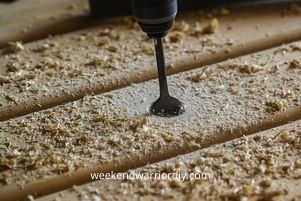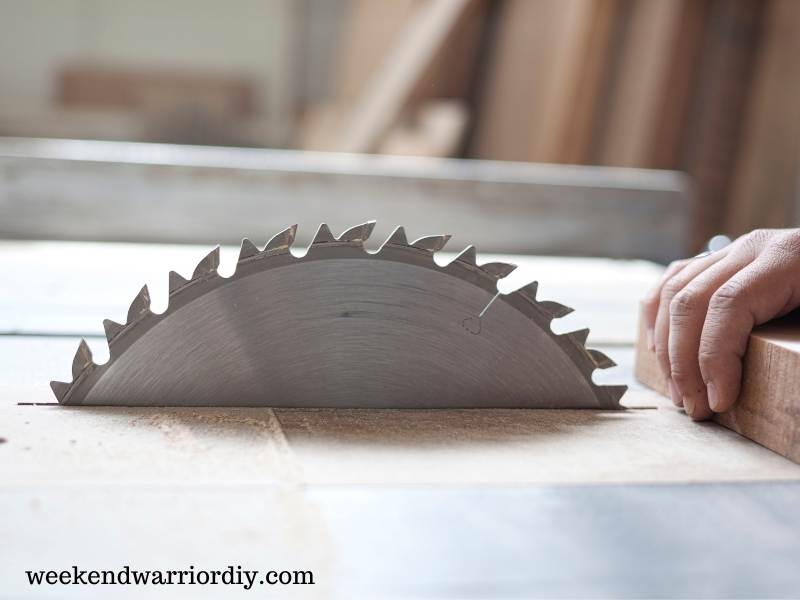Woodworking is gaining popularity at a rapid rate thanks to the online exposure it gets – whether through Facebook, Pinterest, Etsy or other sites. I understand that there are many people currently living in apartments who are interested in woodworking but are wondering how to get started?
Woodworking when you live in an apartment is possible. To successfully do woodworking in an apartment you’ll need to set up your woodworking area properly. As well, using the best tools for woodworking in an apartment will be just as important.
On top of what I just told you, there are other aspects of woodworking in an apartment that you should take into consideration. You’ll want to make sure you have done some soundproofing as well as installed some sort of dust collection system. If you do both, you won’t have to worry as much about your neighbors complaining about your woodworking in the building.
In this article, I’ll cover everything you need to know and more! I’ll discuss the do’s and don’ts of woodworking in an apartment, whether you are new to the hobby or simply unaccustomed to apartment living. So, if you’re ready to learn more, then let’s begin!
How to Set Up a Woodworking Workshop in an Apartment?
The best way to have success at woodworking in an apartment is to set-up everything the best way possible in advance to achieve your woodworking goals.
I know that’s just a general and obvious statement however, if you have never done this before and you happen to be reading this article, then chances are you aren’t 100% confident in what needs to be done.
Here are the steps to be taken when setting up your workshop.
- Select the right space to do woodworking in an apartment.
- Address and minimize the noise that electric tools make, (soundproofing).
- Purchase and assemble the best power tools for your woodworking needs.
- Keep sawdust under control – fumes are a separate concern.
- Assess when the best time is to do woodworking in an apartment.
How to Select the Best Workspace for Woodworking in an Apartment?
Depending on the space available, you’ll either have a dedicated space for woodworking or you’ll need to move tools and tables in and out of an area each time you want to work.
I really hope you have a dedicated space as moving tables in and out can be a real pain. Although, if that’s what you have to do, then that’s what you will do, right?
In my mind, the absolute best space for doing woodworking in an apartment (if it is dedicated space) would be either a spare bedroom or a formal dining area that can be used just for woodworking. The bedroom is the best choice as you’ll have a closet and a door to contain your workshop.
I know some apartments have large balconies with a storage room area on the balcony and a door. If you could find enough space in that area, then maybe that’s the best option for you.
If a dedicated space is not an option for you, then your objective is to identify a space in your apartment that can easily be converted from a normal living space to a woodworking space.
My recommendations for this – consider using a dining area, a large hallway, a balcony or split a bedroom or living room in half. If you’re sharing a space, then you’ll need to use rolling work benches, rolling wood supply storage units, tools and tool kits that are easily moved.
Only you will know which option is best for your situation.
When considering those options, make sure to think about the noise the tools will make as well as the sawdust you need to keep under control.
How to Soundproof a Woodworking Area in an Apartment?
There are two sides to soundproofing your apartment woodworking area. You can soundproof the room itself and you can also purchase power tools that are quieter than others. For quieter tools, I’ll touch on that more below in the section regarding tools needed for woodworking in an apartment.
To soundproof a woodworking space, you should consider the floors, the walls, and the ceiling. Don’t forget doors and ventilation where sound can travel through duct work.
I understand that living in an apartment means you probably can’t do much regarding changing anything structurally, so we’ll only discuss how you can soundproof a woodworking area without doing that.
Of course, if you could drill holes in the walls and spray in some foam insulation, that would help wonders – but you can’t, so we won’t discuss it any further. It’s just an idea.
Let’s start with the flooring. I won’t try to tell you to add laminate with rubber backing because the laminate will just get ruined. You should expect that larger tools will scrape along the floor and other items will fall on the floor, likely damaging it.
My recommendation is to install ¾” plywood on your floor. The thickness of a ¾” plywood floor on top of your regular flooring will add a lot of noise reduction. It’ll also protect your flooring underneath from damage.
For installation, I don’t think you should attach it to the floor. Just cover the whole area with the plywood, ensuring all the joints are butted up tight and if you want, use some tuck tape to tape the seams. If installed correctly, the plywood shouldn’t move.
By adding the tuck tape on the joints, it’ll give the floor as a whole the strength it needs not to shift. Remember too, if you have larger tools and tables on the flooring, that’ll also secure the plywood in place.
Let’s talk about soundproofing your walls and doors now. For any walls or doors, I really like to use rigid insulation. It can be purchased in large sheets so you can cover your walls easily. I recommend purchasing the thickest, most rigid insulation you can afford to attach to the walls and doors in your woodworking apartment.
To install the rigid insulation, you can’t screw it to the walls, or you will have too much damage to the building. That might not sit well with your building’s owners. I recommend using a two-sided tape to attach to the walls. I use it to hang woodworking on the walls in my home so surely, it’ll work for much lighter rigid insulation.
For added soundproofing on the doors, even if you attach insulation to the back of them, you can hang thick sound absorbing curtains above the doors and windows. This will also help muffle sound coming from your woodworking area.
If you prefer not to use rigid insulation, another product you could use is soundproofing studio panels. This option is much more expensive than rigid insulation, but the walls would probably look better with these panels.
For extra insulation, why not install rigid insulation and then studio panels on top? You have two materials then for sound absorption and deflection.
How to Soundproof a Ceiling in an Apartment Woodworking Area?
This is the tough one – how do you soundproof an apartment ceiling so you can muffle the sound coming from your power tools?
I’m going to suggest you use rigid insulation on the ceiling if possible. There really isn’t much else you can do. Anything else will possibly start to fall-down over time, causing you issues in your workspace.
If you can, you could install rigid insulation and then drywall the ceiling again and finish it by mudding and then painting. That’s a big job but, if you’re going to be doing woodworking in that space for a long time, then why not do that instead?
These are just ideas, of course, and I don’t expect you’ll do anything that will jeopardize you being able to live where you are.

What are the Best Tools for an Apartment Woodworking Workshop?
There are two sides to this aspect of your workshop. You want tools that are able to perform the type of woodworking projects you plan to do and you need power tools that are a bit quieter than others of the same type.
Only you can decide what tools you need for your upcoming projects. I can make some recommendations though, to help you wrap your head around the options and possibilities.
For this section, I’ll go over the most popular power tools needed for a woodworking space and give you my thoughts on either how you could use them or if they are even a good idea to be used in an apartment.
In an apartment, you won’t be doing large woodworking projects building farmhouse kitchen tables or entertainment centers. You might build benches or shelving, maybe things to hang on the wall like honeycomb shelves or other fun items you can find on Pinterest. I’ll consider that when talking about the tools below.
Table saw. I’m torn on this one. A table saw seems like such an important part of a woodworking space and honestly, it is. But in an apartment, it might be a problem. If you know you need a table saw for dado or angled cuts, then maybe you need to get one.
You could opt for a circular saw and build some jigs to use for dado type cuts. That’s just an option.
The only way I would use a table saw in an apartment is if it’s a higher end saw. The higher end table saws don’t vibrate as much, nor are they as loud as cheaper models.
I would recommend starting with the most expensive table saw you can afford. I have always liked Dewalt saws and this one is an excellent one to use in an apartment.
It even has a stand with wheels for ease of moving around.
If you don’t have to worry about the sound and or you are limited with space, you can purchase a compact table saw like this one over on Amazon.
Drills and drill presses. Depending on what type of woodworking you’re doing, just having a drill could be sufficient. Unless you are doing work with Forstner bits, which usually work best with drill presses, you probably don’t need a drill press – as nice as they are to have around.
Speaking of Forstner bits, if you want to use a drill with them and want your holes to be perfect, why not create a drill jig? This way all the holes made by Forstner bits will be square with the wood.
Back to drills. You’ll most likely need a drill for drill holes or screws. There are some drills that are a bit quieter than others. Milwaukee sells one that has an oil drive and doesn’t vibrate as much as other brands.
That said, for the size of the power tool and all of the soundproofing you have hopefully done, you can probably get away with using just about any cordless drill for your woodworking.
Power Sanders. Sanding is a big part of creating beautiful pieces of woodwork. You can get away with a palm sander in an apartment woodworking set-up.
I don’t think the sound is much of an issue. Sanders can have a higher pitch, but I feel that with your soundproofing efforts most palm sanders won’t be an issue.
Circular saws. Since your workspace will be somewhat limited in an apartment, I really like the idea of not using a table saw and using a circular saw in its place. Using a circular saw is also a cheaper option that a table saw.
The standard blade size for circular saws was 7 ¼” but not that long ago, manufacturers started making saws that use a 4 ½” blade. These newer styled circular saws are easy to use and about the same as the 7 ¼” variety.
You can also get the 4 ½” style with cordless models.
These saws are versatile and can be used for pretty much any type of cut you’ll need to make in an apartment woodworking set-up. I recommend getting one.
Routers. Most woodworking projects will benefit from being worked on with a router. This is one of those tools you must have.
You don’t need a full-size router anymore, because now there are palm/compact sized routers available. I think you can even hook them up to a router table. If you can’t hook one up to a router table, then you have your first important project to knock off which would be a router table.
Routers can be very loud, so make sure your soundproofing is solid before using one or you might be annoying your neighbors.
Bandsaws. I like using a bandsaw, but I’m not sure if you really need one if you have a circular saw and a scroll saw.
If you go with a bandsaw, make sure to get a tabletop version and not a floor model.
Scroll saws. For anyone doing woodworking in an apartment, I guarantee you’ll need a scroll saw!
Scroll saws are gaining popularity, just like the woodworking hobby is. Whenever you need to cut inside the of the wood, you’ll want to use a scroll saw.
The woodworking projects you can accomplish with a scroll saw are endless. Scroll saws are also very loud, so make sure you have all your soundproofing up to par.
Jigsaws. A lot of the jobs you can do with a scroll saw you can do with a jigsaw. Sometimes all it takes is using a different sized blade and slowing the speed down on the jigsaw and then you can do all kinds of projects with these versatile power tools.
A jigsaw is a must have for your woodworking arsenal.
Lathes – Wood turning in an apartment might not be the best idea. Lathes can be very large pieces of equipment and the vibration from the motor running will probably be felt by other tennants in the building.
If you can find a small version of a wood lathe, then give it a try. However, I wouldn’t recommend a full-size lathe in an apartment.
What is the Best Workshop Set-up in an Apartment?
Setting up where you place everything in your workspace will depend on what power tools you have and what projects you will be working on.
The best suggestion I can give to you is this: prioritize the tools you will be using most. If you are using power tools that should be secured in place like a scroll saw, then do that.
I also suggest having locking wheels on the bottom of your worktables so you can move things around as needed.
Having fold-away tables that secure to a wall and can be pulled down when needed is another great idea.
Sometimes building your tables as you create your workshop is the best way to go about setting everything up. It might take a few adjustments but over time, you will have your space set-up the best way for you.
How do You Keep Sawdust from Getting Everywhere?
Almost as important as having the right power tools is keeping the mess they make under control.
Saw dust will get just about everywhere if you let it.
You could just go with a shop vacuum or if you are serious about keeping the dust under control, then investing in a dust collection system is the way to go. You can buy one or you can build your own.
A dust collection system for an apartment wouldn’t be as big of a set-up as in a larger workshop so lucky for you, it won’t cost a lot of money either!
This dust collection system will work wonders for an apartment woodworking shop. It’s compact and can easily be moved around from one power tool to the next.
Depending on your budget, you can also purchase air filtration systems for workshops that hang in the air and will pick-up a lot of the much finer saw dust floating around before it makes it out into your living space. Here’s an example over on Amazon.
How to Ventilate an Apartment Woodshop?
Ventilation is important, regardless of where you are woodworking. Ventilation is more of a concern when the space is smaller. I’ll assume your apartment woodworking space is a bit smaller than an average workshop.
Easy and obvious things to do are having windows that open with fans running for air movement.
If you want to be proactive, remember that dust control and ventilation are two different things. For ventilation, you want fresh air entering your workspace and stale air moving out.
Having some sort of system set-up, whether it’s a couple of small fans and an open window or a full-blown ventilation system, is crucial to your health. Once you start using paints, stains, sealants, and other products on your projects, you don’t want to be breathing that stuff in if you can avoid it.
This is probably a good time to recommend using higher end dust masks that not only prevent or minimize the dust you breathe in, but also help with vapors.
What are the Best Times to do Woodworking in Apartment?
One part of woodworking in an apartment you probably want to consider is when you start turning on the power tools.
Turning on a table saw at 7:00 in the morning probably won’t go over well if others around you are still sleeping.
Mid-day to early evening is probably the best time. Unless you have a neighbor that does shift work, then you might be better off to have a chat with him/her and see if you can agree on a time that works best for the both of you.
Conclusion
In conclusion, I just wanted to say it’s really important you consider everything provided to you in the article, if you want to be successful in woodworking in an apartment.
I didn’t go over storage, with regard to power tool and supply storage. What I would suggest is to only buy materials you know you’ll be using in a short period of time and only have out the specific power tools you need for your project.
Unless you have a large enough workspace to have everything out, then don’t worry about it. However, accumulating tools and supplies becomes an issue very quickly (in my experience) so deciding in advance what you need will help you keep things under control.
I hope this article has been of help to you. Thanks for reading and good luck woodworking in your apartment!
Related Posts
Should You Buy a Trim Router or Plunge Router? A Comprehensive Guide
Which Way Does a Table Saw Blade Turn?



